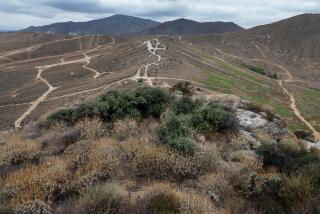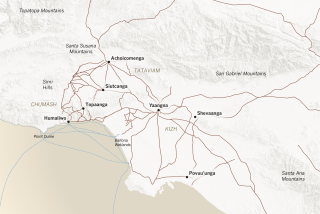Basques Left Their Mark in Forests
- Share via
TRUCKEE, Calif. — In the mountains and forests of the American West, there lies a veritable archive tracing the history of Basque shepherds who once roamed the land. It is recorded not on paper, at least not in the traditional sense, but on trees.
Dating as far back as the mid-1800s, thousands of tree carvings etched by sheepmen have been discovered across the region. Now, researchers are working to document them before they’re lost to time or vandals.
“This is a museum,” says Joxe Mallea, a researcher at the University of Nevada in Reno, who has identified some 20,000 carvings--half of which he’s captured on video. “No one else kept track of them, so they did it themselves. There’s no better history than this.”
Mallea, himself an immigrant from Bizkaia, Spain, first stumbled across the carvings about 12 years ago while on a weekend hike on Peavine Mountain near the California-Nevada line. He spotted something etched in the trunk of an aspen tree but couldn’t make it out. Then he saw another and another and, finally, a Basque surname.
He began returning on weekends, eventually recording some 500 carvings on Peavine alone before expanding his research to other parts of Nevada and California.
“This became my passion,” explains Mallea, who last year published a book on his research, “Speaking Through the Aspens: Basque Tree Carvings in Nevada and California.”
The carvings, ranging from intricate portraits of women to crude etchings of names and dates, seem to represent four main themes, Mallea says. First and most popular are those revealing the identity of an artist, in the form of name, date, hometown and patriotic messages such as “Viva France.”
Another common theme was sheepherding itself. Some carvings describe the weather or a particular pasture, or even rate the various camp tenders who delivered food to the herders.
“There was a great deal of competition among them,” Mallea says. “Some would say, ‘I am the best herder because my lambs weigh so much.’ ”
The loneliness that pervaded the job also was a popular theme, often depicted in portraits of women.
In an aspen grove about 15 miles north of Truckee, in the Tahoe National Forest, the figure of one woman in particular is carved on tree after tree after tree. In one portrait, she wears a cap reminiscent of those women fancied in the 1920s and ‘30s, when Mallea believes the carvings were done. In another, the word “home” is etched beneath her. In one, she wears nothing but a pair of high-heeled shoes.
The grove is one of about 50 in the 800,000-acre Tahoe National Forest, according to forest archeologist Michael Baldrica. Baldrica works with Mallea to record the carvings and is examining ways to preserve the tree trunks after they die to protect the carvings for years to come.
Mallea hopes to document as many carvings as possible and eventually transfer them from video to computer disc. He estimates that much of the work already has been lost due to man or to the short life span of aspens, usually less than 100 years.
Others are doing similar work elsewhere across the West, in Arizona and Oregon, for example, but Mallea is among the few researchers who can read Basque.
To him, the carvings are more than a rare art form: “It’s the freest, most democratic history there is.”
More to Read
Sign up for Essential California
The most important California stories and recommendations in your inbox every morning.
You may occasionally receive promotional content from the Los Angeles Times.










